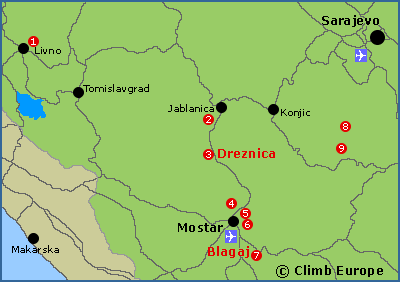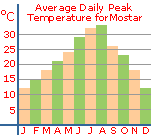Rock climbing around Mostar
Mostar is located in the Herzegovina region of Bosnia, and it is known for its diverse landscape that range from wild mountains and fertile valleys, to the Neretva River that dominates the city of Mostar. This region has a number of high-class climbing areas, dominated by Blagaj, the largest climbing area in the country. Add in Dreznica (one of the oldest), the newer Mostar city crags, and the good bouldering at Spijonik, there is a good diversity of climbing to be found in Herzegovina.
Map of the rock climbing areas around Mostar

| No | Crag | Total No of routes | Up to 4c | 5a to 5c+ | 6a to 6c+ | 7a to 7c+ | 8a and above | Max Height |
|---|---|---|---|---|---|---|---|---|
| 1 | Livno | 19 | 4 | 1 | 13 | 1 | 0 | 45m |
| 2 | Komandinovo vrelo | 13 | 0 | 4 | 6 | 3 | 0 | 28m |
| 3 | Drežnica | 123 | 13 | 41 | 56 | 11 | 2 | 110m |
| 4 | Podružje | 8 | 0 | 0 | 4 | 4 | 0 | 22m |
| 5 | Stolac | 37 | 2 | 14 | 19 | 2 | 0 | 90m |
| 6 | Rupa | 8 | 0 | 2 | 1 | 2 | 3 | 20m |
| 7 | Blagaj | 222 | 8 | 43 | 107 | 49 | 15 | 200m |
| 8 | Spijonik | 62 | 20 | 11 | 29 | 2 | 0 | Bouldering |
| 9 | Gradina | 5 | 0 | 1 | 2 | 1 | 1 | 27m |
Blagaj, with its spectacular Vulin potok canyon, has quickly become the largest, and most diverse sport climbing area in Bosnia and Herzegovina. The climbing is located on the edge of the cosy village of Blagaj near a monastery dating from the 16th century (part of a UNESCO World heritage site) and in the huge canyon. There are more than 220 excellent sport routes at Blagaj with a great diversity of styles and grades, plus a few multi-pitch routes up to 200m long. The routes are on limestone rock with tufas, crimps and crack lines of all grades, requiring good strength and footwork of equal measures. Due to the various sectors facing different orientations it is possible to climb at Blagaj throughout the year, with the best conditions from the autumn through to the early summer.
Dreznica is one of Bosnia and Herzegovina’s largest crags and was at the forefront of sport climbing being developed in the country. The picturesque, exposed location is in a canyon with great rock quality and a cosy climbing atmosphere, located at the crossroads of the Neretva River and its tributary Drezanka river. Here there are over 120 routes, mostly on technical, compact white and grey limestone rock offering a variety of climbing styles, mostly in the intermediate grades. These range from steep bulges and overhangs, to technical friction slabs and crimpy face climbing as well as interesting cracks. The climbing is predominantly single-pitch and it includes some long 40m routes that will drain your whole body and forearms, plus one multi-pitch route that is 110m long.
The bouldering at Spijonik is located in a huge Alpine environment at a height of around 1,500m. From the road it’s an easy and beautiful 40 minute hike to get to the boulder field. Currently there are 3 sectors with over 60 problems mostly in the easier grades up to 7a, and a few open projects. This wide Alpine playground has the potential for at least 150 more. The best time to boulder at Spijonik is from May through until October.
Mostar climbing logistics
The Bosnia and Herzegovina rock climbing guidebook covers 45 climbing areas, including all of those around Mostar. In total it details 1,540 single pitch sport routes, 123 multi pitch routes and 2 bouldering areas with 131 boulder problems. It also includes valuable information regarding travel and accommodation.
Mostar has its own International airport, with another good option being the airport at Sarajevo. Mostar has a growing tourism industry, and the surrounding mountains provide a wide range of activities, including kayaking, mountain biking, hiking, and mountaineering as well as rock climbing.
